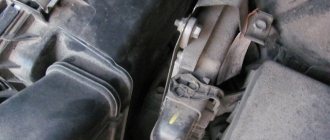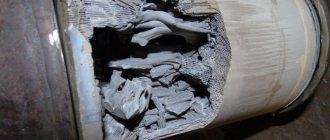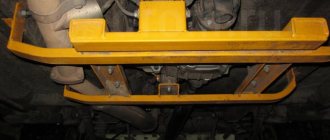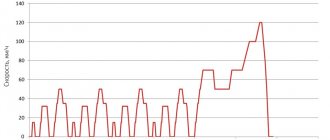- December 23, 2020
- Cars
- Nadezhda Zorina
"Niva-2121" is one of the most famous Soviet and Russian SUVs. This car first appeared in the second half of the 20th century. "Niva-2121" is still being produced. But new models of this SUV are already available with injection engines. Models with carburetor engines can also be found now, but only on the secondary market.
Quite often, many motorists wonder which Niva-2121 is better - with an injector or a carburetor? So, with the Niva injector it is more reliable.
Features of a carburetor car
Before deciding on the choice of a carburetor or injection Niva, it is very important to familiarize yourself with the technical characteristics of both SUV models.
The very first Niva-2121 engine was taken from the Zhiguli. In both the first and second cars, the engine had a large combustion chamber volume, that is, its working volume was 1580 cubic centimeters. Thanks to this engine, it was possible to develop power up to 80 horsepower. And the car could accelerate to 100 km/h in just 20 seconds.
Many novice motorists quite often ask specialists: what is the fuel consumption of the Niva-2121? The carburetor installed on the car affects the difference in fuel consumption compared to a car with an injection engine. Let's consider this nuance in more detail.
For example, judging by the technical data sheet of the car, then 13 liters is the fuel consumption of the Niva-2121. The carburetor, or rather its presence, greatly influences this indicator.
Over time, the engine became more and more modernized. And such an engine began to be numbered 21213. The working volume of the new engine became 1690 cm3, while the power of the power unit amounted to 83 horsepower.
Thanks to the new engine, the car has become more playful. It now takes 18 seconds to accelerate to 100 km/h. It is worth noting that with the introduction of the new engine, fuel consumption has decreased significantly: in contrast to the fuel consumption of the Niva-2121 with a carburetor (1.6 l), it has become less.
For example, if you look at the technical data sheet of an SUV, you will see that the manufacturer claims 11 liters. And as car owners themselves note, this figure is 13 liters.
In winter, the fuel consumption of the Niva-2121 with a carburetor is higher, since at this time it is necessary to warm up the car quite often and for a long time.
Owner reviews
- Ivan, Nikolaev. VAZ 2121 is one of the best SUVs, especially when you consider the cost of the car. It is suitable not only for outdoor trips, but also for city driving. I have owned the car since 2002, the 1.7 engine with a carburetor is very reliable, 80 horsepower is enough to pull the car well off-road and on the highway. Average consumption is about 12 liters per hundred, but you can save money by installing gas, which is what I’m thinking about now.
- Nikolay Chelyabinsk. I have been driving a VAZ 2121 for more than 10 years and have no intention of changing it - it is an ideal second car for fishing and hunting trips. The 1.6 engine is not very dynamic, but my average speed does not exceed 90 km/h. But in any mud it pulls so well that even the UAZ Patriot cannot keep up with it. I'm not even talking about fashionable foreign cars. What is the fuel consumption of my Niva? About 14 liters, which is quite normal for such a car.
- Anatoly, Volokolamsk. I bought a Niva in the back of 2121 in 2012, with a mileage of 80 thousand km. Since then I have not left the cabin either in winter or in summer. In terms of cross-country ability, this is simply a standard - no car can compare with it. The 1.7 liter engine consumes about 13 liters in a circle, both AI 92 and AI 95 eat with equal appetite. I would also like to note a fairly comfortable interior, but the trunk is a bit small, but this is nitpicking.
- Sergey, Ufa. I have a VAZ 21213 with a 1.7 engine and a manual transmission, which I inherited from my grandfather. He took great care of the car, I try not to let him down and also monitor its condition. I change the oil and filters myself, carry out maintenance and minor repairs, and don’t break the car off-road or in deep snow. Consumption at speeds of 65-80 fuel consumption on the VAZ 21213 is about 11 liters per hundred.
- Valery, Peter. I bought the car from the secondary market and chose an inexpensive, practical modification with a 1.6 engine. The car is surprisingly playful in the city, but off-road, in my opinion, there is not enough traction. The engine regularly consumes both 92 and 95 gasoline, consumption is about 12 liters per 100 km.
- Alexey, Chernigov. I own a Lada 4x4 with a 1.7 carburetor engine. All-wheel drive and a manual transmission with locking are an excellent option for off-road use. Maybe I came across such a car, but the reliability leaves much to be desired, however, repairs are inexpensive. The power of 80 horses is enough to drive equally confidently in city mode, on the highway, on country roads and off-road.
- Bogdan, Lipetsk. I'm an avid fisherman, so I can't do without a good SUV. I chose the VAZ 2121 not only because of the price, but also because of its excellent cross-country ability and I don’t regret it. If necessary, I repair my Niva myself, the consumption was about 13 liters, after installing gas it increased to 17 kg per hundred, but in terms of money it is much more economical.
- Denis, Kharkov. Over the six years of owning the VAZ 2121, I have driven more than 120 thousand km, I have absolutely no complaints. Yes, the suspension and transmission require regular repairs, but I do everything myself, and spare parts are quite affordable. I change worn out parts in advance, so I have never gotten stuck even on severe off-road conditions. The 1.7 carburetor engine with 80 horsepower pulls well, fuel consumption on my Niva 2121 does not exceed 13 liters.
- Nikolay, Saratov. I have a 2000 Niva with a 1.7 engine with a carburetor. I have been driving it for more than 10 years, there are complaints about reliability, but with straight hands it is easily repaired and will never let its owner down. Consumption on the highway is 9 liters, in the city about 14.
- Grigory, Khanty-Mansiysk. Over the 8 years of owning my Niva, I have driven almost 200 thousand km. The car is comfortable, passable, quite reliable, ideal for going fishing and hunting. It doesn't matter if it's hot, rainy, muddy or snowy, it will get you where you need to go. Now the Xray Lada has appeared, but, according to reviews, it does not reach the performance of the VAZ 2121 on off-road. Therefore, I’m not going to change it; the consumption of 14 liters per hundred, even in severe frosts, completely satisfies me.
- Alexander, Moscow. I bought the car in 2003 specifically for fishing trips. I immediately liked the car for its comfort, cross-country ability, and torquey 1.7 engine with 80 horses. Relative disadvantages include fragility and a small trunk, which, however, is quite enough for me. The average consumption rate is 12 liters in summer and 13 in winter.
- Valentin, Leningrad region. Despite the monocoque body, the Niva is one of the best SUVs I know. The 1.7 injection engine is powerful and reliable, consuming no more than 12 liters per 100 km. The manual transmission is designed for off-road driving, which the car copes with very well. The car runs great on 92 gasoline - this is another advantage.
- Svyatoslav, Pskov. I have a Niva 2121, I’ve already driven 150 thousand km on it, and I consider it the best off-road option considering the affordable price. The injection version of the engine pulls well and is characterized by increased reliability. High ground clearance does not prevent the car from feeling quite confident on the track. I further increased the cross-country ability by installing non-standard large-radius wheels. On the highway the car consumes no more than 10 liters, in the city and off-road up to 13 liters.
- Anatoly, Samara. I chose different off-road options, settled on a VAZ 2121 with an injection engine, and did not regret it. High ground clearance, small body overhangs - ideal geometry for off-road driving. The interior is comfortable and roomy, even though the body does not have rear doors.
- Vladimir, Novosibirsk. The car was purchased in 2021, I took the 83-horsepower version with a volume of 1.7. I liked the versatility of the car, it feels great in the city, it can be parked in any spot. As for the off-road characteristics, they are generally recognized; I go to the dacha, fishing, hunting in any weather. The car consumes 10 liters on the highway, in the city and off-road up to 13 liters.
- Nikolay, Grodno. The fuel-injected VAZ 21214 is an excellent SUV for a very reasonable price. That's why I chose him. If used carefully, the car will never let the owner down; spare parts are quite accessible; I repair it myself. But permanent all-wheel drive also has a downside - my average consumption is 13 liters, which is a lot for such a small car.
- Andrey, Gatchina. Thanks to the spacious body, I chose the VAZ 2131 with five doors. It has the off-road qualities of a regular Niva, feels good in the city, and is quite roomy. The 1.7 engine with a manual transmission pulls well on the highway, through arable land or a shallow ford, consumes about 13 liters, and on the highway you can achieve 10 liters.
- Dmitry, Volgograd. My VAZ 2131 with a 1.7 engine equipped with a fuel injection system is an ideal option for domestic roads. Only UAZs can compare with it, but they are more expensive to maintain and consume more fuel. The interior of the five-door Niva is roomy and comfortable, spare parts are inexpensive, they can be found at disassembly sites for pennies. Consumption does not exceed 13 liters, and on the highway you can achieve 9.
- Anton, Ekaterinburg. I took the car in 2003, I knew what I was getting into, since I had to spend a lot of time on repairs. But the five-door body is comfortable and roomy. The 1.8 engine pulls great in any mode, but requires timely maintenance. Consumption is 14 liters per 100 km.
- Gennady, Moscow. When choosing, I settled on the most powerful version of the Niva 2131 with a 1.8-liter engine. Even with it, the dynamics in the city leave much to be desired, with a consumption of 14 liters. But outside the city the car is transformed, despite the elongated body, it drives great. On the highway you can accelerate to 145 km/h.
- Stepan, Tomsk. I bought this car under the influence of my son, who carefully studied the parameters of the VAZ 2131 and considered that this was the best option for me. He was not mistaken - this is a really good car. The 1.8 engine is strong and reliable, although on the highway there is not enough power, but in the city and off-road it performs well. I love going fishing; you can load a group of 4 people into the car and not be afraid of getting stuck. Fuel consumption in a circle is about 13 liters.
Features of an injection car
The Volzhsky plant completely switched to injection engines in 2005. These changes affected not only the Niva-2121 SUV, but also many other cars. The new engine received a new number - 21214. The volume of the new gasoline unit began to be 1690 cm3. As for its power, it remained the same, the same as the carburetor - 83 horsepower. The acceleration remained the same, nothing has changed.
The fuel consumption of the Niva-2121 with an injector decreased, in contrast to the carburetor engine, by about 1.5 liters. This is already a big advantage compared to previous Niva models.
As for the average fuel consumption of the Niva-2121 per 100 km, these figures look like this:
- If you drive exclusively on the highway, then 8.3 liters will be spent per 100 km.
- If you drive exclusively around the city, then per 100 km the fuel consumption will be 12 liters.
- And if you drive in mixed mode, 100 km will require 10 liters of gasoline.
These data were obtained under standardized conditions using special measuring equipment.
Today, Niva-2121 is produced with an engine whose index is now 21214-28. The volume of the working engine is now 1774 cm3. The power of the new engine is 92 horsepower. And the SUV began to accelerate a little faster; it could accelerate to 100 km per hour in just 17 seconds. At the same time, fuel consumption does not exceed 10 liters.
How much do injection and carburetor engines consume?
Fuel consumption on a Niva with an injector engine will be slightly less than on a carburetor analogue. One of the most popular power units (or rather, almost the only one) is the 1.7 liter engine. On the highway it takes relatively little, for such a vehicle - only 9-10 liters. Despite the relatively small volume of the gas tank, it will be enough for long country trips up to 400 kilometers.
If you use primarily 5th gear, then fuel consumption can be reduced to an even smaller value - 8 liters. This is facilitated by an injection engine, which is more economical compared to a carburetor engine. However, urban driving mode will be wasteful for the Niva owner, since here you can often spend 13 or 14 liters “per hundred”. And this is still in the warm season, because when driving it in winter, be prepared to increase consumption by another 2-3 liters. This is all due to frozen or slippery road surfaces, and, of course, the voracious power unit.
What is a carburetor
If we compare the carburetor Niva and the injection one, we can conclude that the first is more archaic and old. The carburetor is the main component in this system. That is, it is this mechanism that, during operation, mixes air with a portion of gasoline, thereby creating a flammable mixture. The system itself is a simple device. But, despite this, many car owners are not entirely happy with this engine, since quite often it let them down.
A carburetor engine contains: a float, jets, and needles. It is worth noting that all these mechanisms require regular cleaning and regulation.
Engine and fuel consumption in Niva 2131 and 2121 cars
Legendary 2131 model
The Niva, whose fuel consumption depends primarily on the specific brand of this car and its engine, is a popular and inexpensive Russian SUV. For example, the VAZ 2121 model from 1976 to the present time is equipped with a 1.6-liter 2106 engine, which has the following characteristics:
- cylinder block - cast iron;
- power supply - injector or carburetor;
- engine type - in-line;
- cylinder diameter - 79 mm;
- four cylinders;
- two valves per cylinder;
- power of the Niva 2121 car - at 5400 rpm - 75 hp;
- torque - at 3000 rpm - 116 Nm;
- fuel - AI92;
- motor weight - 121 kg;
- oil consumption 0.7 liters per 1000 km;
- the amount of oil in 2106 is 3.75 liters;
- the amount of oil poured during measurement is 3.5 liters;
- According to the factory, the engine resource is 125,000 km, in practice - up to 180-200 thousand km.
Disadvantages of the carburetor
The main disadvantages include the following:
- This engine is unreliable. That is, almost every season it is necessary to service the carburetor and adjust it.
- Such a motor is highly dependent on air temperature. Mostly problems arise in winter with such an engine. For example, if you overfill the spark plugs, it will be impossible to start the car. To do this, you will have to unscrew them and dry them. In addition, in winter the float often gets stuck, this is due to condensation. In the summer, many Niva owners with a carburetor engine are faced with such a problem as an overheated fuel pump.
- Low productivity. To increase the engine's potential, it is necessary to spin the engine to high speeds.
- Very high fuel consumption.
It is worth noting that, despite the fact that this power system is quite simple and repairable, it requires special attention. Many car owners should prepare in advance for the fact that they will have to rebuild the carburetor several times every year.
What affects fuel consumption
Fuel consumption is difficult to make ideal, since it is influenced by a huge number of factors such as:
- The terrain through which the vehicle is moving;
- Wear of engine parts;
- Fuel quality;
- Ambient temperature;
- Turning on additional electrical equipment (heated glass, air conditioning), etc.;
To reduce fuel consumption, try not to speed up more than 90 km/h, reduce the use of air conditioning, maintain the frequency of the fuel system, and change the filter in a timely manner.
What has changed with the arrival of the new engine?
Today, Niva-2121 is produced only with injection engines. New engines began to use distributor injection, with each cylinder having its own injector. If previously all engine elements were mechanical, now they have become electronic. An electronic control unit also appeared in the SUV.
In order for the injection engine to always operate stably, it is necessary that there are sensors for monitoring air, detonation, and throttle position. This device also includes a crankshaft position sensor.
Although the system may seem very complicated, in reality it is not at all like that. The mechanical part of the motor has not become more complicated. In the injection model, instead of a carburetor, injectors and a fuel rail appeared, and as for the throttle valve, it is now located separately. Electronic sensors appeared.
How not to reduce fuel consumption
It is not recommended to reduce consumption and consumption on your own unless you have the appropriate knowledge and experience . Also, there is no need to make radical changes (switching from gasoline to gas) when this is not clearly necessary.
Make technical replacements or changes in design - here all actions must be coordinated with specialists in the workshop or service station. They will also tell you how much fuel savings will be when choosing one version or another. Making changes to the firmware yourself can cause harm or reduce performance slightly.
Main advantages of the injector
The advantages of the injection Niva include the following:
- High with an injection engine is much faster compared to previous models.
- The operation of the internal combustion engine is stable. That is, due to the fact that the engine has IAC, many car owners have forgotten what floating speed is. Models with a carburetor engine always have real problems with this.
- Low fuel consumption of the Niva VAZ-2121. With the advent of the injection engine, the car began to consume about 20% less fuel.
- This engine is the most reliable. That is, such a motor does not need regular tuning, cleaning, or replacing jets. The only thing that the owner of a Niva-2121 car may need to do is clean the throttle valve. But this procedure is not mandatory. Experts recommend doing this in situations where the car picks up high speed at idle.
What to pay special attention to
Monitor tire pressure. If the tires are not inflated enough, then the surface area in contact with the road surface increases, which increases the fuel consumption of the VAZ 21213 per 100 km.
Experienced drivers know that it is better to use an economical driving style, without sudden acceleration and braking. It is better to move smoothly with a gradual increase in speed and stop. Body aerodynamics should be minimal. To reduce fuel consumption, it is better to remove all unnecessary elements.
Injector disadvantages
As for the disadvantages, such an engine does not have many of them.
Due to the fact that a lot of electronics have appeared in the engine system, car owners may encounter malfunction of control sensors.
In situations where the SUV begins to consume a large amount of fuel, it is definitely recommended to recheck the mass air flow sensor. And if the engine no longer maintains normal speed at idle, then the IAC may be to blame.
And if the engine refuses to start, then it is quite possible that the contact has come loose from the crankshaft position sensor.
It is worth noting that although such problems do occur, they do not happen that often.
You can diagnose these problems yourself, using the simplest multimeter. To do this, it is enough to measure either the resistance or the contact voltage of any of the sensors.
From this we can conclude that breakdowns in most cases occur due to malfunctions of the electronics. As for the mechanical part, it does not raise any questions.
What is the fuel consumption of the Niva 2121 carburetor?
The legendary 2131
Niva model, the fuel consumption of which depends primarily on the specific brand of this car and its engine, is a popular and inexpensive Russian SUV. For example, the VAZ 2121 model from 1976 to the present time is equipped with a 1.6-liter 2106 engine, which has the following characteristics:
- cylinder block - cast iron;
- power supply - injector or carburetor;
- engine type - in-line;
- cylinder diameter - 79 mm;
- four cylinders;
- two valves per cylinder;
- power of the Niva 2121 car - at 5400 rpm - 75 hp;
- torque - at 3000 rpm - 116 Nm;
- fuel - AI92;
- motor weight - 121 kg;
- oil consumption 0.7 liters per 1000 km;
- the amount of oil in 2106 is 3.75 liters;
- the amount of oil poured during measurement is 3.5 liters;
- According to the factory, the engine resource is 125,000 km, in practice - up to 180-200 thousand km.
Good old SUV
The Niva 21214 car has proven to be a successful project, combining the cross-country capabilities of an all-terrain vehicle and the comfortable elements of a passenger car.
It is perfect for weekend trips out of town, weekend trips for fishing or hunting. And even the considerable costs of using a vase cannot upset lovers of this particular car model.
Before buying a car, you should understand what costs will be required to maintain it. Therefore, the manufacturer in the technical specifications indicates fuel consumption data in liters per 100 km. Let's find out what numbers are indicated in the Niva 4x4 documentation and what values are found in practice during the operation of an SUV.
On the official website AvtoVAZ indicates the following fuel consumption per 100 km for the Niva:
- Urban cycle - 12.1 l/100km
- Extra-urban cycle – 8.3 l/100km
- Mixed cycle – 10 l/100km
Summing up
Before purchasing, you should always consider gasoline consumption and the approximate cost of maintenance . SUVs themselves are expensive cars, and not everyone can afford such a car.
Basically, for city driving, small runabouts will be the most budget-friendly option.
Their circulation cycle in the cooling system warms up very quickly and consumes little fuel, which makes them very affordable and economical in winter. Cars need to be roughly divided into groups and bought the one that is ideal for you, depending on the purpose and territory of driving. Based on your personal financial capabilities, you need to understand which model you can afford and what exactly you want.
Fuel consumption Niva 2121 (VAZ)
Any car will last you for the rest of your life if you drive hard enough
VAZ 2121 is a Soviet and now Russian off-road vehicle. The car is always equipped with permanent all-wheel drive. Production began in 1977 and continues to this day without any restyling or generation changes. Niva 2121 is very popular abroad, thanks to its cross-country ability and reliability.











